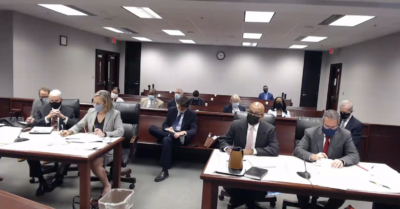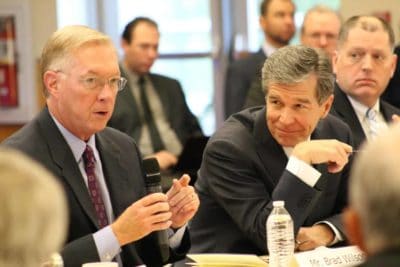

Why has fashioning a 2021-23 state budget, critical to advancing public education in North Carolina, appeared so arduous? Why has the Leandro action plan become so contentious, especially at a moment when the state has had an extraordinary flow of revenue?
On one level, the answers arise from differences over priorities and power in today’s politically divided state. A Democratic governor negotiates with a Republican legislative majority, whose leaders in turn snap back at a Superior Court judge who prods the General Assembly to adopt an education budget in compliance with the state Constitution.
On another level, the answers are deeply rooted in North Carolina’s economic and political dynamics through much of the 20th Century. It is a complex history of paradox, continuity, and change as the state shifted over several decades from a largely agrarian, small-town society to a metropolitan mega-state.
“Continuities in history are seldom, if ever, completely, broken,” the late UNC historian George Brown Tindall once observed. “Tradition has a stubborn way of asserting itself.”
Consider, for example, that North Carolina, along with most Southern states, ranks well below the national average in spending per pupil in K-12 schools. Both the U.S. Census Bureau and the National Education Association (NEA) have issued updated statistics; while their calculations of per-pupil spending produce different totals, they tell a common story. In North Carolina and the nation, per-pupil spending for elementary and secondary schools increased incrementally in the decade since the Great Recession. And yet, in the NEA calculation, North Carolina still falls nearly $3,000 per pupil short of the national average — evidence of a stubborn assertion of a legacy of history.
As recently as the 1970s, N.C. State University economist Mike Walden has pointed out, tobacco, textiles, and furniture accounted for almost one-quarter of all economic production in the state. “Today, the Big Three accounts for less than 10 percent of the state’s aggregate economic production,” Walden writes. “In place of the Big Three is the new ‘Big Five’ sectors of technology, pharmaceuticals, banking, food processing and vehicle parts.”
In the heyday of the Big Three, most jobs on farms and factories — driving trucks and tractors, connecting pipe, sewing seams, cropping tobacco — did not demand much formal education. What’s more, Southern states sought economic development through a low-wages, cheap-land, lax-regulation, low-taxes strategy.
That economic development strategy had a political context. In a set of lectures in the mid-1970s — published in a book titled, “The Persistent Tradition in New South Politics” — Tindall examined three political forces. The “orthodox trinity,” as he called them, consisted of Bourbons, Populists, and Progressives. While the terms populist and progressive remain familiar, Bourbons don’t appear much in contemporary commentary.
“Bourbon came to signify the leaders of conservative democracy,” Tindall wrote, “including not only the mossbacks but the advocates of an industrial New South.” Bourbons supported public health, agricultural research, and higher education even as they were “ardently devoted to laissez fair,” said Tindall. “Bourbon state governments made a cardinal virtue of retrenchment and cut back sharply on expenditures for schools and other public services.”
In the one-party “solid South” era, Bourbons constituted a powerful faction of the Democratic Party. As a result of the partisan realignment touched off by the Voting Rights Act and cultural clashes in the 1960s, the Republican Party absorbed adherents of the Bourbon approach to state government.
The Leandro school finance case originated in the spring of 1994 as a response to the inequalities brought about by North Carolina’s economic transition that left rural districts struggling to provide a quality education. It has traveled a lengthy legal road through Democratic and Republican administrations and legislative majorities of both parties without yet reaching a satisfactory constitutional destination.
The governor, lawmakers, and the judge are not grappling with competing plans to fulfill the state Constitution’s provision for “a general and uniform system of free public schools (in which) equal opportunities shall be provided for all students.” The governor has incorporated the court-ordered plan into his budget proposal. The legislature adopted budget bills the old-fashioned way and without a showing of how they would move North Carolina public education decisively toward equal opportunities for all students. The going is arduous and contentious because the case mounts a challenge to the low-taxes, limited-government tradition that stubbornly persists.




